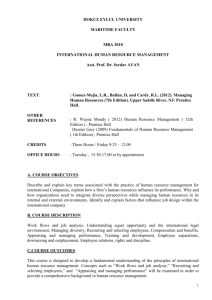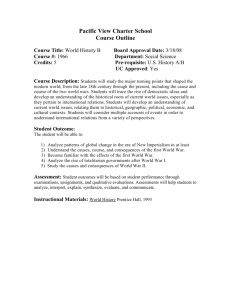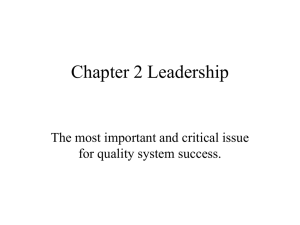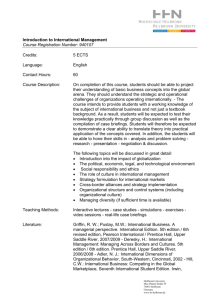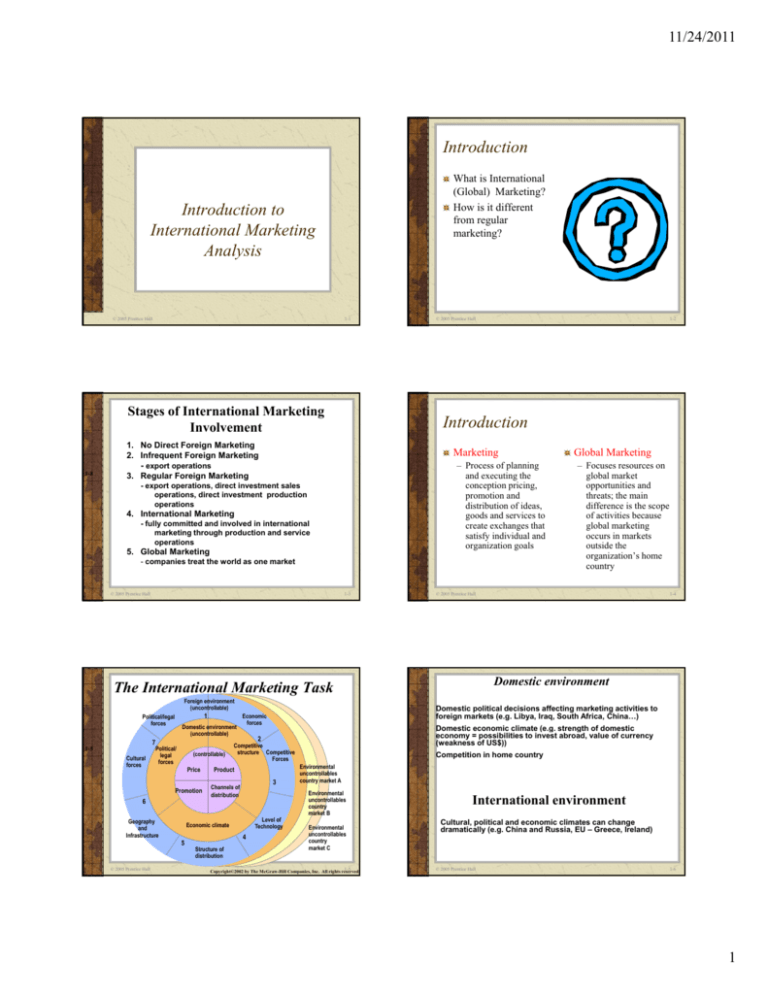
11/24/2011
Introduction
What is International
(Global) Marketing?
How is it different
from regular
marketing?
Introduction to
International Marketing
Analysis
© 2005 Prentice Hall
1-1
Stages of International Marketing
Involvement
1-8
© 2005 Prentice Hall
1-2
Introduction
1. No Direct Foreign Marketing
2. Infrequent Foreign Marketing
- export operations
3. Regular Foreign Marketing
Marketing
– Process of planning
and executing the
conception pricing,
promotion and
distribution of ideas,
goods and services to
create exchanges that
satisfy individual and
organization goals
- export operations, direct investment sales
operations, direct investment production
operations
4. International Marketing
- fully committed and involved in international
marketing through production and service
operations
5. Global Marketing
- companies treat the world as one market
© 2005 Prentice Hall
1-3
Foreign environment
(uncontrollable)
1
7
1-5
Cultural
forces
Domestic environment
(uncontrollable)
Political/
legal
forces
(controllable)
Price
Promotion
Domestic environment
6
Geography
and
Infrastructure
© 2005 Prentice Hall
Product
4
Structure of
distribution
3
Level of
Technology
Economic climate
5
Domestic economic climate (e.g. strength of domestic
economy = possibilities to invest abroad, value of currency
(weakness of US$))
2
7
1-4
Domestic political decisions affecting marketing activities to
foreign markets (e.g. Libya, Iraq, South Africa, China…)
Economic
forces
Competitive
structure Competitive
Forces
Channels of
distribution
– Focuses resources on
global market
opportunities and
threats; the main
difference is the scope
of activities because
global marketing
occurs in markets
outside the
organization’s home
country
© 2005 Prentice Hall
The International Marketing Task
Political/legal
forces
Global Marketing
Competition in home country
Environmental
uncontrollables
country market A
Environmental
uncontrollables
country
market B
Environmental
uncontrollables
country
market C
1-5
Copyright©2002 by The McGraw-Hill Companies, Inc. All rights reserved.
International environment
Cultural, political and economic climates can change
dramatically (e.g. China and Russia, EU – Greece, Ireland)
© 2005 Prentice Hall
1-6
1
11/24/2011
Inititation of
internationalization - Export
motives
Reasons for Global Marketing
Growth
– Access to new markets and access to resources
usually there are many factors which affect
the company’s decision to export
in Hollensen’s book those factors are
devided into two categories: proactive and
reactive - they can also be called push and
pull factors
Survival
– Against competitors with lower costs (due to
increased access to resources) – e.g. India and
China
Or push and pull factors
Proactive motives
© 2005 Prentice Hall
1-7
1-9
– In SMEs export decisions may be the
province of a single decision maker
– in LSEs decision making unit might be
responsible for these decisions
© 2005 Prentice Hall
1-10
3. Technology competence / unique product
If a company produces goods or services which
are unique, a competence edge exists which can
result in major business success abroad
one issue is how long such an advantage will
continue?
these decisions are affected by the
international background of the managers those who have more international
experiences are more internationally
minded
3. Technology competence / unique product
© 2005 Prentice Hall
1-8
2. Managerial urge
managerial urge is a motivation which
reflects the desire of management towards
global marketing activities
often the managerial urge is simply a
reflection of general entrepreneurial
motivation - desire for continuous growth
managerial attitudes play a critical role in
determining the exporting activities of the
firm
1. Profit and growth goals
the possibility for a short term profit may
be especially important to SMEs
experiences from the profitability of export
affect the company’s attitude towards
growing by the means of export (especially
when you start to internationalize the
perceptions about profitability may be far
away form reality)
© 2005 Prentice Hall
© 2005 Prentice Hall
4. Foreign market opportunities
market opportunities act as stimuli only if
the firm has or is capable of securing
resources necessary to respond to the
opportunities
1-11
© 2005 Prentice Hall
1-12
2
11/24/2011
in general decision makers are considering
only a rather limited number of foreign
market opportunities in planning their
foreign market entry
Reactive motives
1. Competitive pressures
a firm may fear losing domestic market
share to competing firms that have
benefited from economies of scale
gained by global marketing activities
further, it may fear losing foreign
markets permanently to domestic
competitors that decide to focus on
these markets
– the market opportunities of similar overseas
markets are explored first
5. Economies of scale
the benefits of decreasing production costs
/ unit by increasing production
6. Tax benefits
© 2005 Prentice Hall
1-13
Competitors are an important external factor
stimulating internationalization (Coca-Cola &
Pepsi)
2. Domestic market: small and saturated
a company may be pushed into exporting
because of a small home market potential
if domestic markets are unable to provide
sufficient economies of scale, export markets
are automatically included in their market
entry strategy
a saturated domestic market has a similar
effect (car manufacturers in USA)
© 2005 Prentice Hall
1-14
3. Overproduction / excess capacity
• if domestic sales are below expectations =>
inventory can be above desired levels =>
with short-term price cuts export is started
• when domestic markets are normal, global
marketing activities may be terminated
(Canadian paper and pulp producers)
4. Unsolicited foreign orders
• many small companies have become aware
of export market opportunities by accident
(advertising, exhibitions etc.)
1-15
5. Extend sales of seasonal products
• seasonality in demand conditions may be
different in domestic market from other
international markets
• this can act as a stimulus for example to
market skiing shoes to New Zealand during
summer or harvesting machines to Argentina
during winter
6. Proximity to international customers /
psychological distance
• German firms established near Austrian
border may not even perceive their
marketing to Austria to be international
© 2005 Prentice Hall
© 2005 Prentice Hall
© 2005 Prentice Hall
1-16
the same situation in Europe exists between
Germany and parts of Switzerland, France
and part of Belgium, Sweden and parts of
Finland, Netherlands and part of Belgium
Between USA and Canada (partly with
Mexico)
1-17
© 2005 Prentice Hall
1-18
3
11/24/2011
Global Marketing: What it is and
What it isn’t
Global Marketing: What it is and
What it isn’t
Strategy development comes down to two
main issues similar to single country
marketing
– Target market
– Marketing Mix
© 2005 Prentice Hall
1-19
Global Marketing: What it is and
What it isn’t
1-20
Standardization versus Adaptation
Globalization (Standardization)
Global marketing does not mean doing
business in all of the 200-plus country
markets
Global marketing does mean widening
business horizons to encompass the world
in scanning for opportunity and threat
© 2005 Prentice Hall
© 2005 Prentice Hall
– Developing standardized products marketed worldwide
with a standardized marketing mix
– Essence of mass marketing
Global localization (Adaptation)
– Mixing standardization and customization in a way that
minimizes costs while maximizing satisfaction
– Essence of segmentation
– Think globally, act locally
1-21
Standardization versus Adaptation
© 2005 Prentice Hall
1-22
The Importance of Global Marketing
For US-based companies, 75% of sales
potential is outside the US.
– About 90% of Coca-Cola’s operating income is
generated outside the US.
For Japanese companies, 85% of potential is
outside Japan.
For German and EU companies, 94% of
potential is outside Germany.
© 2005 Prentice Hall
1-23
© 2005 Prentice Hall
1-24
4
11/24/2011
Environmental adaptation
Management Orientations
To adapt marketing programs to foreign markets certain amount
of adaptation is needed (take uncontrollable elements into
consideration)
In broad sense the uncontrollable elements constitute the
culture – the difficulty is in the recognition of the cultural
impact
Ethnocentric:
Home country is
Superior, sees
Similarities in foreign
Countries
The problem in adapting to foreign markets is self-reference
criterion (SRC) and an associated ethnocentrism
SRC is an unconscious reference to one’s own cultural values,
experiences and knowledge as a basis for decisions –
ethnocentrism: one’s own culture knows best how to do things
Regiocentric:
Sees similarities and
differences in a world
Region; is ethnocentric or
polycentric in its view of
the rest of the world
To avoid this misconception remember that it makes sense for
the other person to do things in his/her own way, if you don’t
remember this you might fail in recognizing cultural differences
and the importance of those differences
© 2005 Prentice Hall
1-25
Concept
EPRG Schema
1-8
Domestic Market
Extension
(Ethnocentric)
Multi-Domestic Market
(Polycentric)
Global Marketing
(Regio/Geocentric)
Geocentric:
World view, sees
Similarities and
Differences in home
And host countries
© 2005 Prentice Hall
Strategic orientation to
international markets
1-9
Polycentric:
Each host country Is
Unique, sees differences
In foreign countries
1-26
It is expected that differences in the complexity and
sophistication of company’s operations depend on
which orientation guides its operations
Among the approaches describing the orientations from
casual exporting to global marketing is EPRG schema
- in this schema the firms are classified as
ethnocentric, polycentric, regiocentric or geocentric
depending on the international commitment of the
firm
- in this schema it is also assumed that the degree of
internationalization to which management is
committed or willing to move affects the specific
international strategies and decision rules of the
firm
Domestic market extension orientation
© 2005 Prentice Hall
1-27
Copyright©2002 by The McGraw-Hill Companies, Inc. All rights reserved.
It views its international operations as secondary and as an
extension of its domestic operations
The primary motive is to market excess domestic
production
Minimal, if any, efforts are made to adapt the marketing mix
to foreign markets
In EPRG schema these companies are classified as
ethnocentric
Multidomestic market orientation
A company guided by this orientation has a strong sense
that country markets are vastly different and that market
success requires an almost independent program for
each country => development of country based
marketing strategies
Control is usually decentralized
In EPRG schema these companies are classifies as
polycentric
© 2005 Prentice Hall
1-29
© 2005 Prentice Hall
1-28
Global marketing orientation
A company guided by global marketing orientation is referred to
as a global company: its marketing activity is global and its
market coverage is the world
It develops a standardized marketing mix applicable across
national boundaries
In EPRG schema these companies are regiocentric or
geocentric
© 2005 Prentice Hall
1-30
5
11/24/2011
Forces Affecting Global Integration
and Global Marketing
Driving Forces
– Regional economic
agreements
– Market needs and wants
– Technology
– Transportation and
communication
improvements
– Product development costs
– Quality
– World economic trends
– Leverage
© 2005 Prentice Hall
Forces Affecting Global Integration
and Global Marketing
Restraining Forces
– Management myopia
– Organizational culture
– National controls
Global
Integration
and
Global
Marketing
1-31
© 2005 Prentice Hall
1-32
6

